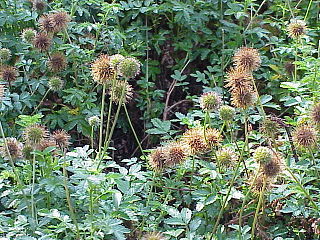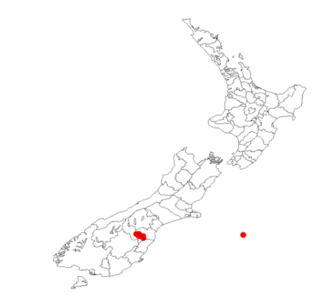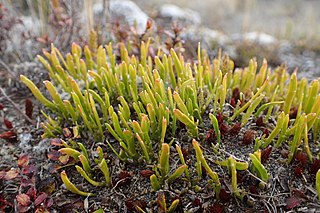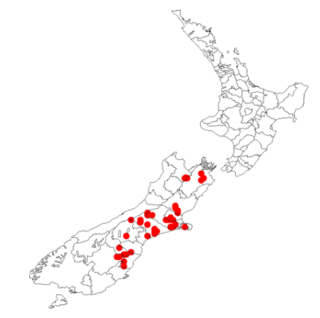
Acaena is a genus of about 60 species of mainly evergreen, creeping herbaceous perennial plants and subshrubs in the family Rosaceae, native mainly to the Southern Hemisphere, notably New Zealand, Australia and South America, but with a few species extending into the Northern Hemisphere, north to Hawaii and California.

Acaena rorida is a species of mat-forming perennial plant known only from grassy uplands on the Mangaohane Plateau in the northwestern part of the Ruahine Range in the North Island of New Zealand.

Chionochloa rubra, known commonly as red tussock grass, is a species of tussock grass in the grass family.

Tussock grasslands form expansive and distinctive landscapes in the South Island and to a lesser extent in the central plateau region of the North Island of New Zealand. Most of the plants referred to as tussocks are in the genera Carex, Chionochloa, Festuca, and Poa.

Phyllocladus alpinus, the mountain toatoa or mountain celery pine, is a species of conifer in the family Podocarpaceae. It is found only in New Zealand. The form of this plant ranges from a shrub to a small tree of up to seven metres in height. This species is found in both the North and South Islands. An example occurrence of P. alpinus is within the understory of beech/podocarp forests in the north part of South Island, New Zealand.

Acaena magellanica, commonly called buzzy burr or greater burnet, is a species of flowering plant whose range includes the southern tip of South America and many subantarctic islands.

Poa foliosa is a species of tussock grass commonly known as muttonbird poa. It is native to the subantarctic islands of New Zealand and Australia.

Bulbinella rossii, commonly known as the Ross lily, is a species of flowering plant in genus Bulbinella. It is one of the subantarctic megaherbs. The specific epithet honours British Antarctic explorer James Clark Ross, who visited Campbell Island in December 1840.

Leptinella plumosa is a small flowering plant in the daisy family. It is a circumantarctic species found on many subantarctic islands in the Southern Ocean. The specific epithet comes from the Latin for “feathery”, referring to the form of the leaves.

Argyrophenga antipodum, the common tussock or tussock ringlet, is a species of butterfly commonly found in the South Island of New Zealand.
Epilobium brunnescens is a flowering plant belonging to the willowherb genus Epilobium in the family Onagraceae. It is a small, creeping, perennial plant with white or pale pink flowers. It is native to New Zealand and south-east Australia and has been introduced to Northern Europe. Its common names include New Zealand willowherb in Great Britain and Ireland, creeping willowherb in New Zealand and bog willowherb for the Australian subspecies.

Chionochloa antarctica is a species of grass, endemic to the Auckland and Campbell Islands.

Ranunculus pinguis is a dark green, fleshy-leaved buttercup with relatively large, short-stalked flowers and narrow stiff yellow petals that grows in tufts. It is an endemic species of New Zealand on the Auckland and Campbell Islands that flowers from December to January and sets seeds between February and April.

Leptinella filiformis, or slender button daisy, is a species of flowering plant in the daisy family, found only in the north-eastern part of the South Island of New Zealand. Thought to be extinct by the 1980s, it was rediscovered growing on a hotel lawn in 1998, and in the wild in 2015.

Carmichaelia appressa is a species of pea in the family Fabaceae. It is found only in the South Island of New Zealand. Its conservation status (2018) is "At Risk - Naturally Uncommon" under the New Zealand Threat Classification System.

Carmichaelia hollowayi is a species of pea in the family Fabaceae. It is found only in the South Island of New Zealand. Its conservation status (2018) is "Nationally Critical" under the New Zealand Threat Classification System.

Carmichaelia nana is a species of pea in the family Fabaceae. It is found in both the North and South Islands of New Zealand. Its conservation status in 2013 was assessed as "At Risk (declinining)" under the New Zealand Threat Classification System, but in 2018 its risk under the same system became "Threatened-Nationally Vulnerable".

Carmichaelia corrugata is a species of pea in the family Fabaceae. It is found only on the South Island of New Zealand.

Acaena microphylla, the bidibid or piripiri, and outside New Zealand, New Zealand-bur, is a small herbaceous, prostrate perennial flowering plant in the rose family Rosaceae, native to both the North and South Islands of New Zealand. There are two varieties:

Actinotus novae-zelandiae is a plant in the Apiaceae family, native to the South Island of New Zealand.


















